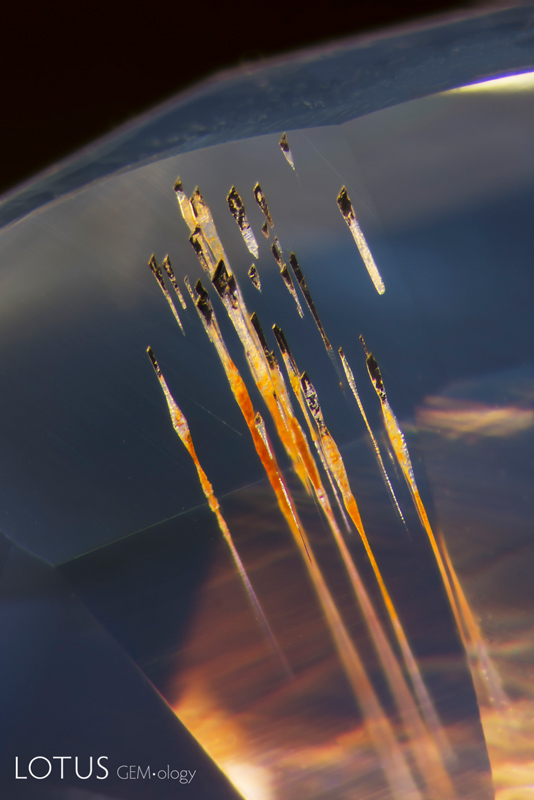Surface-reaching growth tubes in a sapphire provide insight into the gem’s origin and treatment history.
 Surface-reaching growth tubes within a sapphire exhibit unaltered yellowish staining, an indication that the stone has probably not been heated. Combined with other observations, this suggests a possible Madagascar origin.
Surface-reaching growth tubes within a sapphire exhibit unaltered yellowish staining, an indication that the stone has probably not been heated. Combined with other observations, this suggests a possible Madagascar origin.
Photomicrograph by E. Billie Hughes; horizontal field of view 1.4 mm.
Growth tubes are a typical inclusion in corundum and often seen during examination in the laboratory. While commonplace, a stunning cluster such as the one seen above calls out to the photomicrographer. At the surface these tubes are cut through and some black debris has become lodged inside the ends, while deeper within the stone they still display a fiery glow, reminiscent of rockets launching into the sky.
Not only do these tubes spark the imagination, but they can actually tell us a lot about the identity of their sapphire host. The limonitic staining found deeper in the tubes is a yellowish orange, suggesting that they have not been altered by heat treatment. These stains often turn a darker reddish or brownish color in heat-treated stones (J.I. Koivula, “Useful visual clue indicating corundum heat treatment,” Fall 2013 G&G, pp. 160–161).
Furthermore, we have observed in the past several months that these prominent growth tubes are a common feature in Madagascar sapphire. While the tubes can be found in corundum from other origins, they seem particularly common in the Madagascar material that has been entering the Bangkok market in greater numbers recently. When taken into account along with other features, they provide a clue to the origin of these sapphires. Thus, what initially appeared to be a mundane inclusion is both visually impressive and gemologically significant, as it provides hints to the origins and treatments of corundum.

About the Author
E. Billie Hughes visited her first gem mine (in Thailand) at age two and by age four had visited three major sapphire localities in Montana. A 2011 graduate of UCLA, she qualified as a Fellow of the Gemmological Association of Great Britain (FGA) in 2013. An award winning photographer and photomicrographer, she has won prizes in the Nikon Small World and Gem-A competitions, among others. Her writing and images have been featured in books, magazines, and online by Forbes, Vogue, National Geographic, and more. In 2019 the Accredited Gemologists Association awarded her their Gemological Research Grant. Billie is a sought-after lecturer and has spoken around the world to groups including Cartier and Van Cleef & Arpels. In 2020 Van Cleef & Arpels’ L’École School of Jewellery Arts staged exhibitions of her photomicrographs in Paris and Hong Kong.
Notes
This article first appeared in Gems & Gemology, Fall 2017, Vol. 53, No. 3.
